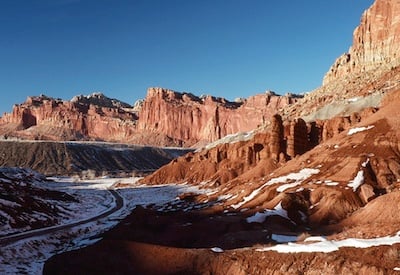Think of Capitol Reef National Park and, if you're familiar with this isolated outpost in Utah's canyon country, you'll likely envision soaring reefs of colorful rock. But few would even imagine battles between mountain lions and lynx.
But that's exactly what transpires from time to time in the park that, despite its nearly 250,000 acres, is often overlooked in a state with better-known national-park destinations such as Zion, Arches, Bryce Canyon and Canyonlands. While it's rare that anyone sees these battles, the winter months are an ideal time to go looking for wildlife in Capitol Reef.
It's during these cold months that it's easier to spot the animals heading for a sip out of the Fremont River that drifts across the park near the visitor center, or from one of the park's other streams. The overall lack of people -- we're counting in the mid-four digits, folks, each month -- creates a quieter atmosphere that the animals seem to be more comfortable with.
"In the winter time people see fox, desert bighorn sheep, and bobcat," says Riley Mitchell, the park's chief of interpretation. "We didn’t see it, but we just had a lynx that was killed by a mountain lion. We didn’t even know we had lynx in the park.”
it, is named after the outlaw Butch Cassidy. Local lore has it that Butch would use the Grand Wash area to hide from pursuing posses. Fruita, of course, dates back to pioneering members of the Church of Jesus Christ of Latter-day Saints who arrived late in the 19th century. They're the ones who planted the orchards so they could sell the fruit to surrounding communities.
This lynx was quite the traveler, as biologists had tracked its wanderings all the way to Idaho before it headed back south and met its demise by making the ill-fated decision to wander into mountain lion territory.

Capitol Reef's Scenic Drive in winter. NPS photo.
"We do see a lot more visible wildlife (in winter), says Ranger Mitchell. "You still have to look for them. But the possibilities, the potential of being able to see wildlife, is quite elevated because it is quiet. And we have a great little environment for them down here. It’s warmer than the surrounding area. We’re a little enclave of warmer temperatures and not such gusty winds.”
It was in 1971 that Capitol Reef was transformed by President Lyndon B. Johnson from the national monument that President Franklin D. Roosevelt had created in August 1937 into a national park. The most prominent topographical and geological landmark of this park is the Waterpocket Fold, a 100-mile-long (161 km) uplift of rock formed about 65 million years ago by buckling of the Colorado Plateau.
This maze of rock canyons, draws, and cliffs is great to explore if you're properly equipped. Indeed, in summer the high heat and dry climate can be challenging for those who don't set out with enough water, and flash floods can be devastating and deadly to those who park in the wrong spot or don't pay enough attention to the weather. But the solitude available year-round in this immense landscape can be downright luscious.
Most visitors understandably arrive in May and June, when the orchards of Fruita are in bloom, and in September and October, when those orchards are ripe for harvest. And you can enjoy this harvest, as park visitors can pick to their heart's content from the apple, peach, apricot and cherry trees. There's no charge for fruit you eat in the park, while a small fee is levied if you want to take fruit away with you.
As noted above, the winter months draw few to Capitol Reef. The sun goes down too soon to allow long wanderings during the day, the nights can be cold, and the park is decidedly off the beaten path during a time when few folks are traveling for fun. But if you find the time, and make the effort, you'll be rewarded not only by more visible wildlife, but by some of the best landscape photography conditions, as the season's low angle of the sun "really brings out the color in the cliffs, the textures, the patterns, those kinds of things,” points out Ranger Mitchell.
Though most folks approach Capitol Reef as a "drive through" park on their way to or from one of Utah's other national parks, Capitol Reef has incredible assets for those who stop, hoist a pack on their back, and head off into that landscape. There are trails that lead you through slot canyons and into sprawling gorges, -- places called Muley Twist, Burro Wash and Hamburger Rocks -- and, for those comfortable with self-reconnoitering, well, any direction will reward.

Cassidy Arch in the distance, Capitol Reef National Park / NPS - D. Popovic
Now, there's a little Western history here as well. Head up Grand Wash a bit and you'll find Cassidy Arch, which, you guessed it, is named after the outlaw Butch Cassidy. Local lore has it that Butch would use the Grand Wash area to hide from pursuing posses. Fruita, of course, dates back to pioneering members of the Church of Jesus Christ of Latter-day Saints who arrived late in the 19th century. They're the ones who planted the orchards so they could sell the fruit to surrounding communities.
Long before the Mormons arrived, though, bands of Native Americans now called the Fremont lived here, and left their mark in the form of petroglyphs and pictographs on sandstone palettes you can find next to the Old Fruita Schoolhouse.
Today Capitol Reef is somewhat of an anomaly among the 58 "national parks." It's big, wide and handsome, but enjoys relatively scant visitation, making it the perfect escape.
Traveler trivia: A great place to stay, if you're not into pitching a tent in the park's campground, is the SkyRidge Inn, a charming B&B in Torrey that's set on a hillside with views down into the park.





